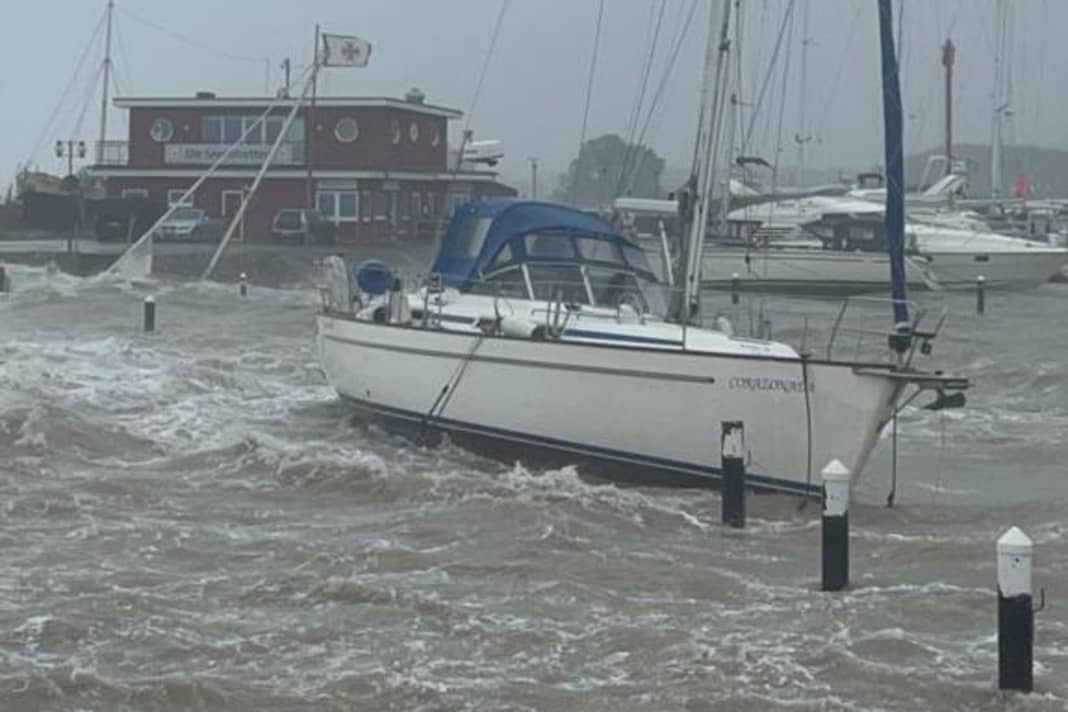The flood of the century: The storm surge night of 20 October 2023 on the Baltic Sea






The warnings were clear: It was clear days in advance that the coast would be hit hard, with orange and red colours dominating the wind forecast maps. The Federal Maritime and Hydrographic Agency issued the first announcement for a possible storm surge on Tuesday, 17 October 2023, followed by further storm surge warnings in the coming days with expected water levels of one to two metres above mean sea level.
Nevertheless, many yachts apparently remained unprepared in the water.
On the night of 20 October 2023, the Baltic Sea coast experienced the worst storm surge in 150 years - harbours such as Schilksee and Damp resembled a battlefield, over 150 yachts sank and hundreds were destroyed. Reconstruction cost more than 200 million euros and is still ongoing to this day. Two years on, we take stock: what happened on that night of horror, how did the reconstruction go, and are we better prepared for the next flood of the century?
The night of horror: Friday, 20 October 2023
A low pressure system named Wolfgang moved over the Bay of Biscay and the UK and met a blocking high pressure area over Scandinavia, which led to strong easterly winds over the Baltic Sea. Wind speeds of over 50 knots were constantly measured from Rügen to Flensburg, with gusts of over 70 knots.
The storm surge was significantly higher than predicted by the models: In Eckernförde Bay, the Baltic Sea rose to +2.10 metres above the mean water level, in Flensburg even to +2.37 metres - the highest value measured since the millennium flood of 1872.
Sailor and author Jan von der Bank described the events as follows: "What happened between around 6 and 10 p.m. was an apocalypse and one of the worst things I have ever experienced in connection with sailing. You can read his full report here. YACHT editors were also on their boats that night. What incredible things they experienced, read here.
The devastation in the harbours
The Olympic harbour in Kiel Schilksee was particularly badly affected. According to Sporthafen Kiel GmbH, 48 ships sank. The pier was undermined and sank by around 20 centimetres. In Damp, only 110 of the previous 365 berths were still available for emergency use, with 32 boats sinking there alone.
The managing director of the surveyor's office MCS - Marine Claims Service reported a total of around 400 damaged ships, 150 of which had sunk. The total volume of damage in the boat and yacht insurance sector could amount to over 20 million euros. The total damage to coasts, beaches, flood defences, harbours and boats in Germany was estimated at around 200 million euros. The detailed damage report is read here.
More on the topic
The difficult reconstruction
The challenges were enormous. Most of the necessary salvage operations were only possible from the water, the necessary equipment was limited and the narrow jetties with boats lying close together slowed down the complex work considerably. The city of Kiel ordered that all damaged or sunken vessels had to be salvaged by a specialist company by 31 October 2023 at the latest. YACHT was on site and accompanied the salvage teams. Click here for the report.
A site visit in mid-January with the managing director of Sporthafen Kiel GmbH, Philipp Mühlenhardt, gave a surprisingly good first impression: the chaos had been cleared up and there were still around a dozen damaged yachts on the site. Workers were rebuilding the main jetties in an icy easterly wind and sub-zero temperatures, and materials were purchased immediately after the storm to prevent supply bottlenecks.
Mühlenhardt was optimistic: "We will manage Kiel Week and the berths should also be free. However, the repair of electricity columns and water connections may take longer here and there.
For Damp, the state of Schleswig-Holstein pledged 17.9 million euros in funding for the reconstruction of the harbour, which is not only to be put back into operation, but also made more weatherproof and attractive - complete restoration by the 2028 season. last until summer 2026.
Are we better prepared?
Even two years after the disaster, the question remains: how can such events be prevented or mitigated in future?
The Schilksee breakwater has been raised to its old height of 2.5 metres, but a significant increase for the future would be very costly - a new construction would be a multi-million euro project, the financing of which is still unclear.
One month before the severe storm surge, researchers at Kiel University had already been able to prove in a study that the entire German Baltic Sea coast is exposed to a high risk of flooding and that improvements to coastal protection are necessary - the first coastal protection measures are already underway with the climate dyke concept of the state of Schleswig-Holstein.
After-effects in sailing
The event is obviously still having an impact: Many sailors are still very unsettled and took their boats out of the water earlier than in previous years.
The storm surge on 20 October 2023 was more than just a weather phenomenon - it was a wake-up call. It was the worst flood in 150 years for the Baltic Sea coast. While the physical damage is gradually being repaired, the question of appropriate preventive measures for future extreme weather events remains pressing. For the sailing community on the Baltic Sea, it was a lesson in humility before the forces of nature - and an appeal to take warnings seriously.

